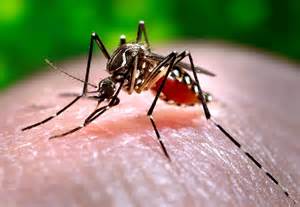
by Sheila Dunning | Aug 13, 2015
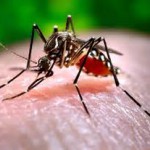 University of Florida researchers maintain a constant vigilance on the potential for mosquito-borne illness concerns. UF/IFAS Florida Medical Entomology Laboratory in Vero Beach tracks rainfall, groundwater levels, mosquito abundance, wild bird populations and virus transmission to animals including horses and sentinel chickens. When mosquito infection rates reach the levels that can infect humans, alerts are sent out. Through the Florida Department of Health, the Centers for Disease Control and Prevention Health Alert Network issues advisories on a weekly basis to those counties at risk. Such an alert was issued for Gadsden, Polk and Walton Counties for the week of July 19-25, 2015. Unfortunately, the first 2015 confirmed human case of West Nile Virus illness in Florida occurred in Walton County shortly thereafter. It was just another reminder for people to take action to reduce their potential for mosquito development in their landscape.
University of Florida researchers maintain a constant vigilance on the potential for mosquito-borne illness concerns. UF/IFAS Florida Medical Entomology Laboratory in Vero Beach tracks rainfall, groundwater levels, mosquito abundance, wild bird populations and virus transmission to animals including horses and sentinel chickens. When mosquito infection rates reach the levels that can infect humans, alerts are sent out. Through the Florida Department of Health, the Centers for Disease Control and Prevention Health Alert Network issues advisories on a weekly basis to those counties at risk. Such an alert was issued for Gadsden, Polk and Walton Counties for the week of July 19-25, 2015. Unfortunately, the first 2015 confirmed human case of West Nile Virus illness in Florida occurred in Walton County shortly thereafter. It was just another reminder for people to take action to reduce their potential for mosquito development in their landscape.
With all the quick afternoon thunderstorms and frequent irrigation events, now is the time to check out where the water is collecting in your yard. The female Culex nigripalpus mosquitoes lay their eggs in temporary flood water pools; even very small ones such as pet watering bowls, bird baths and upturned Magnolia leaves. Dumping out the collection containers every couple of days can greatly reduce the population.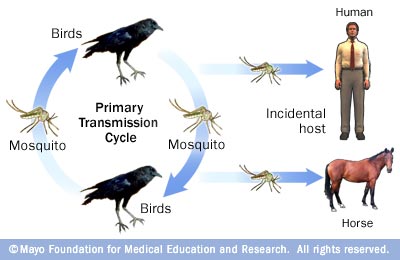
Becoming infected with West Nile Virus is not easy. Mosquitoes usually obtain the virus by feeding on infected wild birds, many of which have migrated from areas that have ongoing West Nile Virus outbreaks. Once the mosquito has drawn infected blood from the bird, the virus goes through a temperature-dependent incubation period within the mosquito. Then, when the infected mosquito “bites” a human or horse the virus mixed in saliva is released into the blood stream of the second host. West Nile Virus is not transmitted from one human to another. Nor is it transmitted from bird to human or from horse to human.
Thanks to a devoted set of researchers and government public health officials, here in Florida we are able to monitor mosquito-borne illnesses quickly and effectively. Additional partners, such as local veterinaries, sentinel bird stations and the Florida Fish and Wildlife Conservation Commission (FWC) serve as reporters for virus population. Should an individual come across dead birds without an obvious cause, reporting them to the FWC at www.myfwc.com/bird/ is the best thing to do.
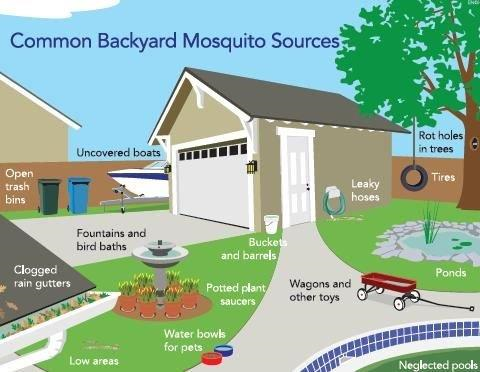 As for protecting yourself, here are a few pointers:
As for protecting yourself, here are a few pointers:
Stay indoors at dusk (peak mosquito biting time).
If you must be outside, wear long sleeves and pants and/or mosquito repellents containing the active ingredient DEET.
Repair torn door and window screens.
Remove unnecessary outside water sources.
Flush out water collected in outdoor containers every 3-4 days.
Disturb or remove leaf litter, including roof gutters and covers on outdoor equipment.
For additional information, contact your local Extension office about obtaining a free Florida Resident’s Guide to Mosquito Control.
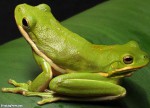
by Sheila Dunning | Jul 7, 2015

There are more than 100 species of plants and animals living in Florida that are in danger of extinction. These trees, flowers, reptiles, amphibians, birds, fish, mammals and invertebrates are listed as either threatened, endangered or species of special concern. As stewards of the land we must question, “What could the loss of a torreya tree, a lupine, a salamander, a butterfly, a woodstork, a right whale, a manatee, a sea turtle or a black bear do to our environment and our quality of life?”
Biological diversity is the variety and variability of species present in an ecosystem including the complex interactions of the many species. Regardless of their size or apparent significance, each species has a role in the circle of life and the food web. Preservation of all species is important. No one knows which ones hold the answers to the future of human existence on this planet.
Many significant developments in medicine have come from obscure plant and animal species. Modern day research includes a vaccine against leprosy being developed because of the nine-banded armadillo and horseshoe crabs being used in developing laboratory tests and finding remedies for several bacterial diseases. In agriculture, genes from wild species may provide the resistance for plant diseases, insects or even weather extremes that could save us from crop failure or possible starvation. There is an interdependence among living things. The extinction of one species may have a domino-like effect on other species. Stability of an ecosystem depends on bio-diversity.
To protect our future and the future of wildlife, the Endangered Species Act became federal law in 1976. This act is intended to protect and promote recovery of plants and animals that are in danger of becoming extinct as a result of human activity. The Environmental Protection Agency is responsible for ensuring the endangered species are protected from pesticides.
Pesticides can kill endangered plants and animals directly or indirectly. Birds mistaking them for food may eat granules, baits or treated seeds. Water contaminated with pesticides ranging in concentrations of less than 0.1 to 1.0 parts per million (ppm) can kill fish. Animals that eat treated crops, drink or wade in contaminated water or feed on tainted prey can be killed indirectly. Some pesticides can build up to lethal levels as predators consume multiple poisoned prey species.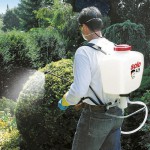
There are certain things you can do to lessen the harmful effects of pesticides on fish and wildlife. Read all pesticide labels carefully to find out whether the use of the product requires special steps to protect endangered species. Determine if the site is designated as the current habitat of an endangered species. Find out this information by visiting http://www.epa.gov/espp/ and http://myfwc.com. When you have a choice of pesticides to use, choose one that is less or non-toxic to fish and wildlife. Read and follow the “Environmental Hazards” section and use the special precautions and measures to minimize harmful effects. Treat only the areas that need to be treated. Leave a buffer zone (untreated area) between bodies of water and treated areas. It is your legal and moral responsibility to protect endangered species by careful use of pesticides in and around their key habitat areas.
Information for this article was derived from University of Florida publications “Pesticide Effects on Nontarget Organisms” by Frederick Fishel and “Applying Pesticides Correctly” by Thomas Dean and Norman Nesheim.
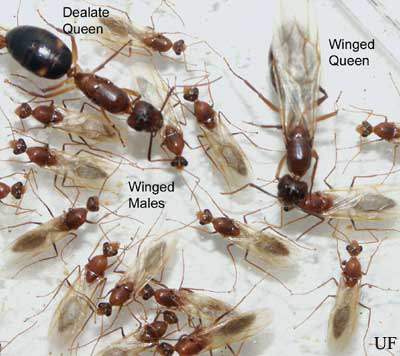
by Roy Carter | May 26, 2015
The proverbial picnic scene aside, ants are pests all of us have to deal with from time to time. Both inside and outside our homes, they feed on and contaminate our food, they build ugly mounds on our lawns, and some ants can inflict painful bites or stings.
Several species of ants are found in Florida. The most common can be grouped into three categories: House-infesting ants, yard infesting ants, and carpenter ants. In this article we’ll talk about ant biology and behavior and how to control them.
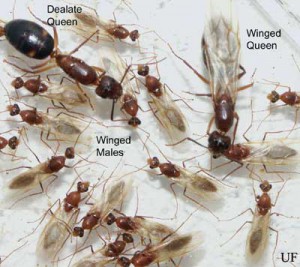
Florida Carpenter Ants. Photo credit: UF/IFAS.
Ants have a life cycle similar to many other insects. They go from egg, to larva, to pupa, to adult. Eggs are almost microscopic in size and hatch into soft legless larvae. The pupa resembles the adult ant, except it is soft, uncolored and immobile. It can take from six weeks to two months from egg to adult.
Ants are social insects. They live in colonies much like bees do. Most colonies have a queen ant, male ants, and worker or female ants. Colonies are started by queens, whose primary function is reproduction. The queen may live for many years and is usually replaced by a daughter queen. Males are produced in very old or large colonies, and their sole function is to mate with the unfertilized female, after which, they die. Worker ants construct, repair and defend the nest, provide food for the colony, and take care of the young ants.
Most ants are omnivorous, which means they will eat anything, through some do have specialized food habits. Ants locate food by random searching; when one ant finds food, she informs the other workers in the colony. The exact method of communication is unknown, but in some cases, ants can leave scent trails that other ants can follow to the food source.
Because ants are attracted to any type of food or food particles, your best bet to controlling ants inside your home is to keep it very clean. Store food in airtight containers. Never substitute insecticides for inadequate housekeeping.
The key to eliminating ants is locating and destroying the colony. Sometimes this can be a real problem, because ants are very adaptable. Outdoor nesting species can sometime nest indoors and vice versa, depending, on the food supply.
To find the ant colony, you have to watch the movement of the ants very closely. Outdoors, many ants are easy to locate, because they deposit earth on the soil surface, and form ant hills. But some outdoor ants build nests under house foundations, in decaying logs, and tree trunks. These can be difficult to locate indoors. Ants may nest in walls, behind baseboards, in cracks, and in decaying wood.
Spray, dusts, granules, and baits can be useful in controlling ants. When using these products, treat baseboards, door and window frames, and cracks and crevices between walls and flooring. Treat all areas where ants appear to have trails. If the nest is located, apply an insecticide to the nest according to the pesticide label.
For more information:
Ants
Fire Ants
Carpenter Ants
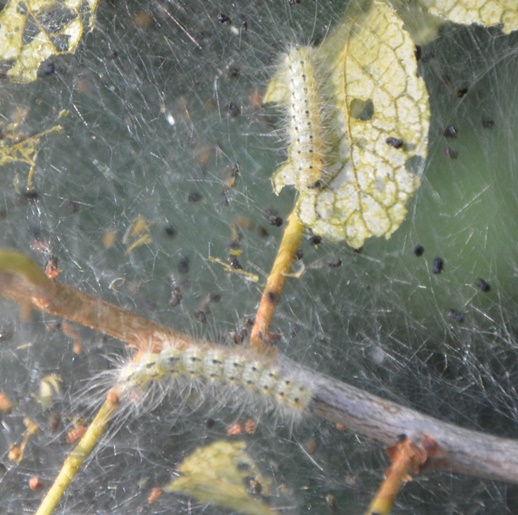
by Les Harrison | May 19, 2015
Uninvited guests can sometimes be fun and entertaining, bringing spontaneity to an otherwise predictable schedule. Sometimes the surprise guest is just an unpleasant distraction with no redeeming virtues.
The unanticipated knock on the door can bring both scenarios to mind. Almost everyone has an enjoyable cousin who regales listeners with amusing tales, and picks up the check for dinner.
Likewise, there are those potential callers with parasitic qualities, the appetite of a market hog, and initiative of a sloth. The Eastern Tent Caterpillar is one such visitor in north Florida.
These native caterpillars build large, thick nests on the branch forks and crotches of many kinds of trees, seeming to always choose the prized specimens highly valued by the homeowner. The silky tent shaped nests are easy to see and identity in host trees.
The caterpillars emerging in the spring of 2015 were laid in the spring of 2014. The adult moth lays her eggs in a single batch in May to July in the panhandle. There are 200 to 300 eggs laid in the group.
The mass of eggs are shiny, reddish-brown and look like dried foam. They are ordinarily about six inches back from the tip of a thin twig in host tree.
In approximately three weeks the eggs contain fully formed caterpillars, but the small caterpillars remain in the eggs until the following spring.
In late-February to mid-March they chew their way through their egg shells ready to eat their host tree that is entering the spring budding period with plentiful tender vegetation.
The voracious larvae immediately infest and, if in sufficient numbers, defoliate plum, cherry and many others. Normally the trees recover after a few weeks, but weakened or diseased trees may die.
When not eating, the newly hatched caterpillars construct their silk tent. The caterpillars use a pheromone trail to guild them back home when foraging is done.
A social insect, the eastern tent caterpillars congregate at their specific tent during the night and in rainy weather, expanding it to accommodate their growing size. These caterpillars do not feed within their nests.
The caterpillars disperse to colonize new areas when maturity is reached. They construct cocoons in protected places once they have sufficiently scattered.
Birds are not attracted to these hairy caterpillars. If they have a heavy concentration of black cherry leaves in their diet, the caterpillars will have a bitter acrid taste.
Parasitic wasps and weather are the two most common causes of caterpillar death. These caterpillars are especially susceptible to cold weather once they have emerged from their eggs.
About two weeks later, an adult moth emerges to begin the process again. Mating and egg laying commonly occur within 24 hours of the moths emerging from their cocoons
These brown moths are nocturnal and are seen flying only at night. They are an inch to two inches wingtip to wingtip at maturity and easy to overlook.

Tent Caterpillars are quick to hatch and eat their way through home landscapes.
Unfortunately, once they arrive for a visit they always overstay their welcome.
Contact your local UF/IFAS County Extension Office to learn more about Eastern Tent Caterpillars in north Florida.
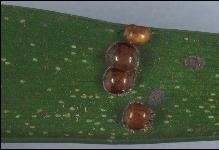
by Eddie Powell | May 8, 2015

Florida soft scale. Photo credit: UF/IFAS.
Scale insects are one of the most serious problems homeowners face on ornamentals this time of year. The most common are armored scale, soft scale, and mealybugs. They cause damage by sucking plant fluids from the leaves, stems, and sometimes roots. Some species feed on the underside of the leaves which can appear as yellowing spots or chlorotic lesions. Heavy infestations can cause extensive leaf yellowing, premature leaf drop, branch dieback, and plant death.
The life cycle starts when the eggs are laid beneath a waxy covering or beneath the adult female. After the eggs hatch two to three weeks later, the nymphs (crawlers) move around the plant until they find a suitable feeding site. Crawlers then insert their straw-like mouthparts into the plant and begin to feed and grow. The male often develops wings and flies to locate a mate.
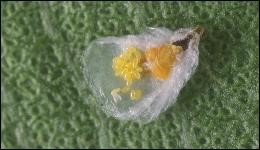
Armored scale nymphs. Photo: UF/IFAS.
Armored scale is distinct from other types of scales because they secrete a waxy covering over their body that is not attached to the body. The scale lives and feeds under this covering ranging 1/16 to 1/8 inch in size. They can be any color or shape, depending on the species. Armored scale does not produce honeydew.
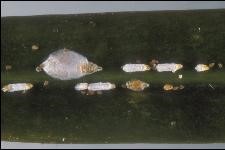
Armored scale. Photo credit: UF/IFAS.
Soft scale also secretes a waxy covering but it is attached to the bodies. Soft scales vary in color, size, and shape. They are circular shaped and range from 1/8 to ½ inch in diameter. Because they consume so much plant sap, they excrete a lot of sugary liquid called honeydew. Honeydew is the sticky liquid found on the leaves.
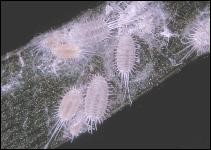
Mealybugs. Photo credit: UF/IFAS.
Mealybugs are soft bodied insects that are often covered with cottony white filaments. They are 1/8 inch in size and feed on all parts of plants. Injured plants have discolored, wilted, and deformed foliage.
Sooty mold is caused when mealybugs and soft scales excrete large amounts of honeydew which provides an excellent medium for the growth of the black fungus. Sooty mold is not only unattractive; it slows down the growth of the plant as it interferes with photosynthesis. Over time, with the control of the insect population, the sooty mold will weather away. Ants can also play a big factor in controlling sooty mold as they will feed on the honeydew.
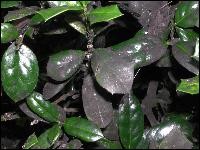
Sooty mold. Photo credit: UF/IFAS.
To control scale and mealybugs, avoid over-fertilizing and monitor your plants often. If the infestation becomes over-bearing, spray a fine mist of Horticultural Oil on the foliage. Avoid spraying in the summer heat because of damaging foliage. Other chemicals that can be used if necessary are Sevin dust and Malathion.
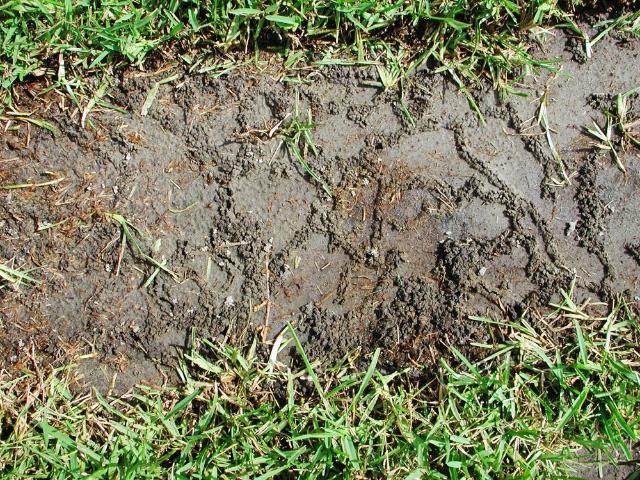
by Larry Williams | Apr 20, 2015
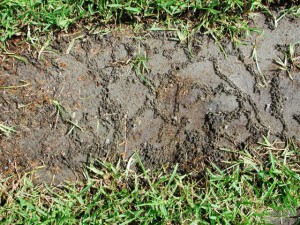
Mole cricket tunnels. Credit: N. Leppla, UF/IFAS
Many people treat their lawn with an insecticide when they see mole crickets in the spring or at the first sign of a brown area in their lawn. What they don’t understand is the biology of this pest.
Mole crickets spend the winter as adults in the soil. As temperatures warm in late February and March, adult mole crickets emerge and begin to mate. Male mole crickets construct a chamber in the soil and chirp to attract female crickets. Attracted females fly to the males. After mating, males die and females fly to a suitable area for egg laying. Mated females begin tunneling and laying eggs in the tunnels. They lay about four clutches of eggs in different areas, averaging 35 eggs per clutch. Female crickets die shortly after laying their eggs.
Use of insecticides during early spring is not recommended because:
- adult mole crickets are not easily killed
- they cause minimal lawn damage during the mating and egg laying process, and,
- reinfestation from subsequent flights is likely.
The best time to treat for mole crickets is during mid-June through July. This will be when eggs have hatched but before the nymphs (immature mole crickets) are large enough to do much damage. Proper timing of the insecticide application is very important to achieve control.
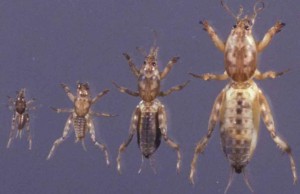
Mole cricket nymphs. Credit: J. Castner, UF/IFAS
If you are not sure if mole crickets are present, you can find out with a soap solution. Mix 1½ fluid ounces of a lemon scented liquid dishwashing soap in two gallons of water in a sprinkling can or bucket. Pour the soapy water over an area approximately four square feet and count the number of mole crickets that emerge. If they are present, it only takes several minutes for mole crickets to crawl to the surface after the soap treatment. Repeat the process around the yard where you suspect mole cricket problems. If you flush an average of two to four crickets per site, treat the lawn with an insecticide. Follow up with spot treatments if any crickets escape the first insecticide treatment. But don’t treat at all if there is no evidence of mole cricket activity.
There are a number of products for mole cricket control in home lawns. Look for insecticides that contain the following active ingredients: bifenthrin, carbaryl, cyfluthrin, deltamethrin, imidacloprid , lambda-cyhalothrin or permethrin.
Before using any product for mole cricket control first identify the problem as mole cricket damage by using the soap flush technique. Then choose an insecticide that lists mole crickets on its label. And finally, read the container carefully for use directions, application techniques, irrigation requirements and precautions.

 University of Florida researchers maintain a constant vigilance on the potential for mosquito-borne illness concerns. UF/IFAS Florida Medical Entomology Laboratory in Vero Beach tracks rainfall, groundwater levels, mosquito abundance, wild bird populations and virus transmission to animals including horses and sentinel chickens. When mosquito infection rates reach the levels that can infect humans, alerts are sent out. Through the Florida Department of Health, the Centers for Disease Control and Prevention Health Alert Network issues advisories on a weekly basis to those counties at risk. Such an alert was issued for Gadsden, Polk and Walton Counties for the week of July 19-25, 2015. Unfortunately, the first 2015 confirmed human case of West Nile Virus illness in Florida occurred in Walton County shortly thereafter. It was just another reminder for people to take action to reduce their potential for mosquito development in their landscape.
University of Florida researchers maintain a constant vigilance on the potential for mosquito-borne illness concerns. UF/IFAS Florida Medical Entomology Laboratory in Vero Beach tracks rainfall, groundwater levels, mosquito abundance, wild bird populations and virus transmission to animals including horses and sentinel chickens. When mosquito infection rates reach the levels that can infect humans, alerts are sent out. Through the Florida Department of Health, the Centers for Disease Control and Prevention Health Alert Network issues advisories on a weekly basis to those counties at risk. Such an alert was issued for Gadsden, Polk and Walton Counties for the week of July 19-25, 2015. Unfortunately, the first 2015 confirmed human case of West Nile Virus illness in Florida occurred in Walton County shortly thereafter. It was just another reminder for people to take action to reduce their potential for mosquito development in their landscape.
 As for protecting yourself, here are a few pointers:
As for protecting yourself, here are a few pointers:













